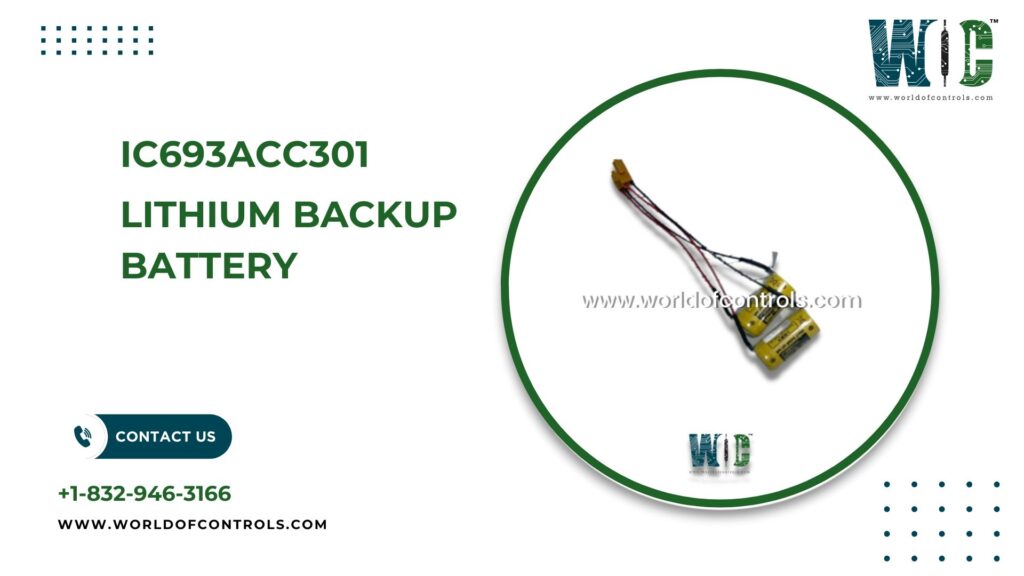
IC693ACC301
In modern industrial settings—especially within the turbine industry—uninterrupted system operation is critical. Power generation systems rely heavily on programmable logic controllers (PLCs) to manage, monitor, and control vital turbine functions. One often overlooked yet crucial component of these systems is the lithium backup battery that ensures memory retention during power disruptions.
GE’s lithium backup batteries are widely used in turbine control applications for their reliability and long shelf life. Properly maintaining these batteries not only helps avoid unexpected failures but also contributes to long-term system performance and operational efficiency.
The Role of Lithium Backup Batteries in Turbine Systems
GE’s PLCs are at the core of many turbine control systems, providing precise and automated control over complex mechanical processes. These controllers store essential data such as configuration files, control logic, and operational parameters.
The lithium backup battery ensures that this non-volatile memory is preserved during power outages or shutdowns. If the battery fails, critical information can be lost, leading to system reprogramming, extended downtimes, and, in worst-case scenarios, damage to turbine equipment or unscheduled production halts.
Why Battery Maintenance is Crucial in the Turbine Industry
Turbine environments are often demanding—exposed to high temperatures, vibrations, and continuous operation. In such conditions, even the most robust battery can experience premature wear if not properly maintained.
Ensuring the health and longevity of your lithium backup battery isn’t just about extending its service life—it’s about maintaining system stability, data integrity, and safety in high-stakes industrial operations.
Top Tips for Extending Battery Life
- Perform Regular Status Checks
GE PLC systems typically include diagnostic tools that display battery status. Schedule periodic maintenance checks to assess battery health. Don’t wait for a failure—monitor battery voltage and condition regularly to avoid surprises.
- Maintain Stable Environmental Conditions
Battery performance and lifespan are strongly influenced by ambient temperature and humidity. Keep control panels within the manufacturer’s recommended operating conditions, ideally between 0°C to 60°C, and ensure that they are protected from moisture and excessive dust.
- Avoid Frequent Power Cycling
Every time a system powers down, the battery kicks in to maintain memory. In environments with frequent power cycling, the battery is used more intensively, shortening its lifespan. Wherever possible, limit unnecessary shutdowns and reboots to conserve battery life.
- Replace Batteries Proactively
Even when not heavily used, lithium batteries degrade over time. Most GE lithium batteries have a shelf life of around five years. As a rule of thumb, schedule replacements every 3–4 years in turbine systems to stay ahead of potential failures.
- Store Spare Batteries Correctly
Having spare batteries on hand is good practice, but they must be stored properly—away from direct sunlight, excessive heat, or humidity. Ideal storage conditions will help preserve the battery’s charge and integrity for future use.
- Use OEM-Compatible Components
To ensure optimal performance and safety, always use genuine or certified-compatible backup batteries designed for GE PLCs. Off-brand alternatives may not meet required specifications, risking performance issues or compatibility problems.
How to Know When It’s Time to Replace
Some common signs that your backup battery may be failing include:
- Warning lights or diagnostic alerts on the PLC
- Unplanned resets or loss of saved configurations
- System behaving erratically after power restoration
Address these signs immediately, especially in turbine applications where even brief interruptions can be costly.
Final Thoughts
In turbine control systems, the lithium backup battery is a small but indispensable component. While it silently supports your PLC by preserving vital data during power loss, its role is anything but minor. By implementing a proactive maintenance plan—including environmental controls, regular diagnostics, and timely replacements—you can significantly extend the life of your battery and ensure the continuous, safe operation of your turbine systems.
Routine attention to something as simple as a battery can help prevent significant operational headaches and financial losses. In high-demand environments like power generation, reliability is everything—and that begins with the details.





